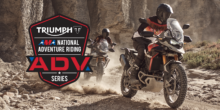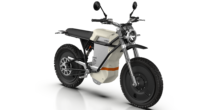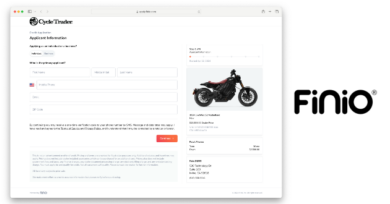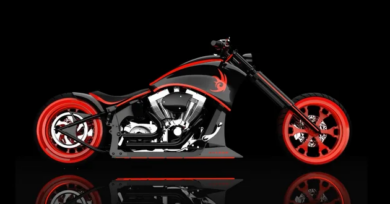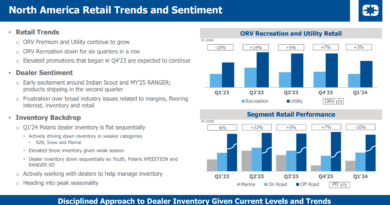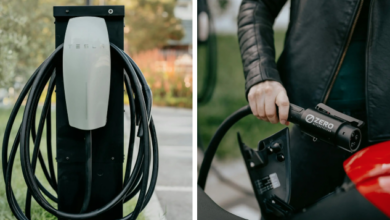Sept. 6, 2010 – An unlikely aftermarket success story
 MADISON, Wis. — It starts a few years ago on a dusty highway in Utah with a guy driving an old Chevy pickup with one hand on the steering wheel and his other hand out the window. The exposed hand being dragged in the wind current is slowly rotated, palm up, then palm down, so it catches the wind at different angles.
MADISON, Wis. — It starts a few years ago on a dusty highway in Utah with a guy driving an old Chevy pickup with one hand on the steering wheel and his other hand out the window. The exposed hand being dragged in the wind current is slowly rotated, palm up, then palm down, so it catches the wind at different angles.
 “My wife thought I was nuts,” says Brian Klock, the guy driving the truck but keeping most of his attention on his pivoting hand.
“My wife thought I was nuts,” says Brian Klock, the guy driving the truck but keeping most of his attention on his pivoting hand.
It’s mostly due to his wife that Klock, then a small motorcycle parts manufacturer, spent so much time on that 18-hour drive from Utah to South Dakota acting like a bored kid in the backseat trying to pass the time. It was also partly due to his wife that a series of unlikely events eventually led to one of the biggest aftermarket successes in recent years.
The beginning
This Hollywood script largely could be filmed in eastern South Dakota, in a town called Emery where the description “rural” seems too much. Too big. Emery, several miles south of the major interstate, has a population that doesn’t quite hit 400. Even the street numbers don’t surpass “7th.”
This is where Klock grew up and later operated a service shop out of a 600-square foot garage, building custom bikes and eventually graduating to developing aftermarket parts for V-twins.
“I was doing a lot of custom baggers because in the wintertime in South Dakota, you’re taking any job you can get,” he said.
Fast forward to the summer of 2007 and the scene changes to the Bonneville Salt Flats in Utah, where Klock is watching his bride, Laura, accelerate to record speeds on a Harley Road Glide. But nagging worries start creeping in as he watches Laura’s motorcycle begin to wobble as the bike hits speeds of 120 mph, then 125, then 130. Despite all the pre-racing precautions the couple took, the bike still is wobbling much more than what is visually comforting to Brian Klock.
“I told her don’t go faster than that,” he said. “Well she doesn’t listen very well.”
And then the doubts turn to fear.
Watching next to Brian Klock are his two new, teenaged daughters, who just months before gave their blessing for the marriage.
“I’m 40 years ago. Never married and never even thought of getting married and now here I am,” Klock recalls of that Bonneville trip. “I’m freaked out because I’m not Mr. Mom. She gets hurt and I’m in trouble.”
His fears, thankfully, are put to rest as the riding concludes without disaster. But the couple later spends time discussing how to get rid of the wobble, specifically how to use air to stabilize a motorcycle.
The answer, strangely enough, comes on a dusty highway, with a hand stretched out of a Chevy.
The answer
The concept is this: Use a windshield to create a down-force drag on a motorcycle. With the visual learning he receives from watching his hand bounce around outside of his Chevy, Klock believes he has an idea on what the proper angle would be to accomplish this.
He designs a couple of windshield prototypes, including one that has elements on the outer edges that he refers to as “hips.” The prototype also has an element on top that is designed to direct air past the rider.
These prototypes are developed in 2007 as Klock sees some growth in his small parts and accessories business. The once custom bike builder now has nearly 40 parts — what he jokingly refers to as “doodads” — in the 2007 Drag Specialty catalog. Klock’s sales climb to a modest $50,000-$60,000.
And then the decision comes.
Through mutual acquaintances, Klock gets connected with somebody who implores him to try the windshield prototype at a wind tunnel testing facility in North Carolina. It’s a dicey decision, although Klock ends up making the long trip, but not without considerable angst over the mounting expenses.
“They (the staff at the testing facility) kept telling me to be quiet because I was concerned about the money,” he said. “They said, ‘We want your wife to be safe’” next time she races at the Utah flats.
The testing takes about an hour. It starts with Laura on a Harley that is placed on scales without the engine running. Wind is slowly introduced and readings are taken to measure the down force on the front and rear of the bike. The first readings measure the Harley with a stock windshield. The second readings measure the same Harley with one of Klock’s prototypes.
“The guys in the control room were high-fiving us after we ran the (prototype) windshield,” Brian Klock says, recalling one of the testing facility staff members turning to him and saying, “Call your patent attorney, kid, you did it.”
The concern
The testing was merely the first step, however.
What loomed ahead was even more trying: Trying to figure out a way to finance it.
On the way home from the testing center, the couple stopped off to see a friend, Harley-Davidson dealer Click Baldwin.
“He said, ‘I’ve never seen you so down,’” Klock recalls. “I said, ‘Click, I’m all in.’”
The money pressures would grow.
Klock found a manufacturing partner in Sportech, a Minnesota-based aftermarket company, and after their first meeting, he quickly asked his wife to fax a purchase agreement for the first batch of windshields.
“My wife said, ‘How are you going to pay for this?’ I said, ‘Well, tomorrow you better set up a meeting at 10 a.m. at the bank. We’re going have to do some fancy talking.’”
Turns out the Klocks weren’t the only ones who would do the talking.
The founder and CEO of LeMans Corp., Fred Fox, called the bank as well. He spoke to the bank official about the similarity he saw in Klock and another upstart aftermarket company that had made a pretty good name for itself — Vance and Hines.
“I’m light on some of their products,” Fox told the banking official. “By tomorrow there will be a pretty substantial order on Laura’s desk.”
The funding was approved.
“It was a huge vote of confidence,” Brian Klock said. “So my loyalty to Fred Fox and Drag Specialties runs very deep because he went to bat for me.”
The blessing
The testing concluded, the funding approved, the big question loomed: Would it all be worth it?
Brian Klock attended the 2008 Cincinnati
V-Twin Expo with the new, patent-pending product and asked Drag Specialties to order 20,000 of them. Drag countered with a much, much lower number: 500.
“Fred Fox came up to me after that meeting and said, ‘Boy, you shot kind of high in there, didn’t ya? That’s a lot, Brian,’” Klock said.
Klock provided his reasoning for the big order: The Flare windshield fit Harleys all the way back to 1985. If you figure roughly that Harley made 100,000 baggers a year, that’s 2 million bikes that it could work on.
“If 1 percent of those people want to be safer on their motorcycle and feel different, I can give them that look and stability,” Klock said.
One percent equaled 20,000 Flare windshields.
“We left there with a lot of confidence and really scared,” he said. “Completely broke. I stuck my neck out. I spent everything I had to produce this windshield and get it launched.”
One year later, the Klocks returned to the V-Twin Expo having sold 18,500 windshields as Drag Specialties kept pace with an ever-increasing interest in the product.
“It has been an absolute blessing from there forward,” Klock said.
Even the ending seems out straight of Hollywood. Today, the Flare sales continue to climb, already surpassing 65,000 units. PSB

